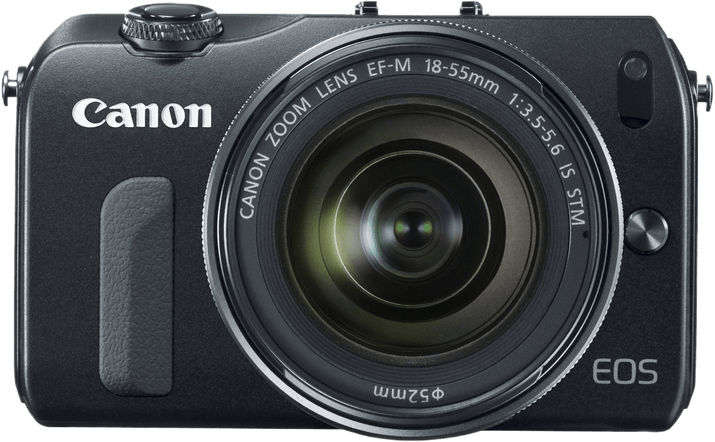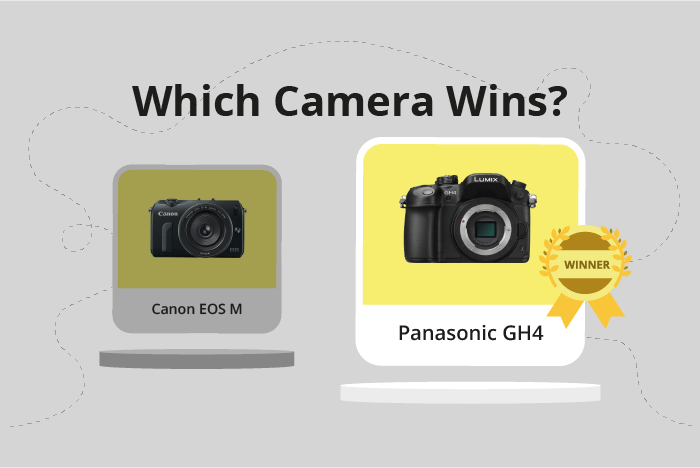Canon EOS M vs Panasonic Lumix DMC-GH4 Comparison
Canon EOS M

Panasonic Lumix DMC-GH4

The Panasonic Lumix DMC-GH4 emerges as the winner with a score of 58/100, outperforming the Canon EOS M, which scored 44/100. Both cameras share some common specifications, such as being mirrorless and having similar announcement and release years (2012 for Canon and 2014 for Panasonic).
The Lumix GH4’s higher score is attributed to its better features and performance. However, the Canon EOS M has some advantages too, such as its smaller size (109 x 66 x 32mm) and lighter weight (298g), making it more portable.
On the other hand, the Panasonic GH4 comes with a heftier launch price of $1700, compared to the Canon EOS M’s $799. This may be a deciding factor for budget-conscious buyers, making the Canon EOS M a more affordable option.
Taking all these points into consideration, the Panasonic Lumix DMC-GH4 is the better camera in terms of performance and features, while the Canon EOS M offers a more compact and budget-friendly alternative.
Canon EOS M vs Panasonic Lumix DMC-GH4 Overview and Optics
The Panasonic Lumix DMC-GH4 outperforms the Canon EOS M in optics, scoring 52/100 compared to the Canon’s 42/100. Both cameras share several specifications, such as the CMOS sensor type, the absence of image stabilization, and similar lens mounts (Canon EF-M for the EOS M and Micro 4/3 for the GH4).
The Lumix GH4 has a superior DXOMARK sensor score of 74, compared to the EOS M’s 65, indicating better overall image quality. Additionally, the GH4 offers a faster shooting speed of 12, while the EOS M only reaches 4.3. This increased speed allows for capturing fast-moving subjects with greater ease. The GH4 also uses the Venus Engine IX processor, which contributes to its higher overall performance.
On the other hand, the Canon EOS M has a higher megapixel count of 18, compared to the GH4’s 16. This can result in higher resolution images, offering more detail for cropping or printing large photos. However, this advantage is not enough to outweigh the other benefits provided by the GH4.
The aspect ratio differs between the two cameras, with the EOS M having a 3:2 ratio and the GH4 offering a 4:3 ratio. This difference comes down to personal preference and the intended use of the images.
The Panasonic Lumix DMC-GH4 proves to be the better choice in terms of optics, with a higher overall score, better sensor performance, and faster shooting speed. The Canon EOS M’s higher megapixel count and different aspect ratio may be appealing to some users, but the GH4’s advantages make it the more compelling option for most photographers.
Canon EOS M vs Panasonic Lumix DMC-GH4 Video Performance
The Panasonic Lumix DMC-GH4 wins the video capabilities comparison with a score of 70/100, while the Canon EOS M scores 43/100. Both cameras share some common specifications, such as Full HD video resolution and a maximum video frame rate of 30fps. However, the Panasonic GH4 surpasses the Canon EOS M in several aspects, making it the superior choice for video recording.
One significant advantage the Panasonic GH4 has over the Canon EOS M is its 4K video resolution, with maximum video dimensions of 4096 x 2160. This allows for higher quality video recording and greater detail in captured footage. In contrast, the Canon EOS M can only record at Full HD resolution with maximum video dimensions of 1920 x 1080.
Another notable feature of the Panasonic GH4 is its built-in time-lapse functionality, which enables users to create stunning time-lapse videos without the need for additional equipment or software. The Canon EOS M lacks this feature, limiting its creative potential for video enthusiasts.
Despite its lower score, the Canon EOS M does have a slightly higher maximum video frame rate of 30fps, compared to the Panasonic GH4’s 24fps. This may be advantageous for users who prioritize smoother motion in their videos.
Considering these factors, the Panasonic Lumix DMC-GH4 is the clear winner in terms of video capabilities. Its 4K video resolution and built-in time-lapse functionality make it a more versatile and powerful option for videographers. While the Canon EOS M does offer a marginally higher video frame rate, it falls short in other crucial areas, making the Panasonic GH4 the superior choice for those focused on video recording.
Canon EOS M vs Panasonic Lumix DMC-GH4 Features and Benefits
The Panasonic Lumix DMC-GH4 takes the lead in the features department with a score of 70/100, compared to the Canon EOS M’s score of 57/100. This 13-point difference highlights the superiority of the GH4 in terms of features.
Both cameras share some common specifications. They both have a 3-inch touchscreen and similar screen resolution, with the Canon EOS M featuring 1,040,000 dots and the Panasonic Lumix DMC-GH4 having 1,036,000 dots. Neither camera has GPS or Bluetooth capabilities.
The Panasonic Lumix DMC-GH4 excels in its additional features. The camera boasts a flip screen, which allows for more versatile shooting angles and is particularly useful for vlogging or self-portraits. The GH4 also has built-in Wi-Fi, enabling users to transfer images and control the camera remotely via a smartphone or tablet.
The Canon EOS M falls short in comparison to the GH4, as it lacks both a flip screen and Wi-Fi capability. However, it is worth noting that the EOS M has a slightly higher screen resolution, offering a marginal advantage in image clarity when reviewing photos on the camera itself.
Considering the specifications mentioned, the Panasonic Lumix DMC-GH4 emerges as the better camera in terms of features. The flip screen and Wi-Fi connectivity give it a significant edge over the Canon EOS M. Meanwhile, the Canon EOS M’s only advantage is its marginally higher screen resolution, which may not be enough to sway potential buyers. Ultimately, the GH4’s superior feature set makes it the more appealing choice for photographers seeking a camera with greater functionality.
Canon EOS M vs Panasonic Lumix DMC-GH4 Storage and Battery
The Panasonic Lumix DMC-GH4 emerges as the winner in the storage and battery comparison with a score of 60/100, significantly outperforming the Canon EOS M which scores 13/100. Both cameras share similarities in accepting SD, SDHC, and SDXC memory cards and lacking USB charging capabilities.
The GH4’s superiority stems from its dual memory card slots, allowing for more storage and flexibility, compared to the EOS M’s single slot. Additionally, the GH4 boasts an impressive 500-shot battery life using the DMW-BLF19 battery, more than doubling the EOS M’s 230-shot capacity with its LP-E12 battery.
The EOS M, however, does not showcase any advantages over the GH4 in this category. Its lower score reflects its limitations in storage and battery capacity compared to its competitor.
Considering these factors, the Panasonic Lumix DMC-GH4 proves to be the better option for those prioritizing storage and battery life, while the Canon EOS M falls short in this aspect.
Canon EOS M vs Panasonic Lumix DMC-GH4 – Our Verdict
Are you still undecided about which camera is right for you? Have a look at these popular comparisons that feature the Canon EOS M or the Panasonic Lumix DMC-GH4:

